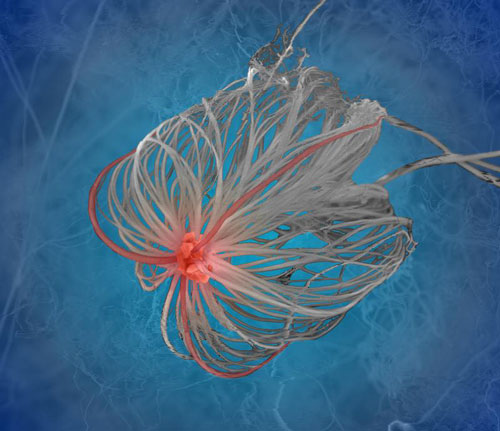| Considered by some to be the "magic bullet" of materials science, carbon nanotubes (CNT) are at the forefront of materials research around the world. Carbon nanotubes are not only extremely stable, they are also excellent conductors of electrical energy and are made from a cheap raw material. Researchers at Saarland University want to use these highly versatile materials to help replace expensive precious metals in electrical contacts by cheaper alternatives such as nickel. By coating these replacement metals with nanotubes they hope to be able to prevent oxidation of the metal surface and thus avoid any associated reduction in electrical conductivity. By using lasers to help grow nanotubes on a silicon plate, the researchers in Saarbrücken have created structures that, when viewed under a scanning electron microscope, resemble a jellyfish in the ocean. This image was recently awarded first prize in the national photo competition "Making Nano Visible". | |
 | |
| With the help of laser beams material scientists from Saarbrücken have made nanotubes grown on a silicium plate and have generated structures that look under the scanning electron microscope as a jellyfish in the sea. For this picture, the researchers received the highest award in the nationwide photography competition "Nano sichtbar machen", which means "Make Nano visible". (Picture: Nicolas Souza/cc-NanoBioNet) | |
| The competition was initiated by the three nanotechnology networks NanoBioNet, ASeNT-D and CeNTech. The €1000 prize will be awarded today at the WING.DE nanotechnology conference organized by the Federal Ministry of Education and Research (BMBF) in Berlin. | |
| Pencils contain graphite, and graphite consists of carbon atoms aligned in layers. When we use a pencil for writing, these carbon atoms get deposited layer by layer. Nanotubes are essentially two-dimensional arrays of carbon atoms that have been rolled up as you would roll up a sheet of paper. Fuente: |
Blog de cursos y estudiantes de Químicas del Departamento de Ciencias Quimico-Biológicas en la Universidad de las Américas Puebla.
Wednesday, November 30, 2011
Material scientist wins competition for best nanotechnology photo
Subscribe to:
Post Comments (Atom)
NEODIMIO ¡no te lo pierdas!

-
Un campo de investigación reciente y muy interesante es el de las máquinas moleculares. Inspirándose en la mecánica biológica, muchos han bu...
-
De entre todos los compuestos químicos que existen, quizá sean los llamados compuestos de coordinación los que mayores dificultades ofrecen ...


No comments:
Post a Comment